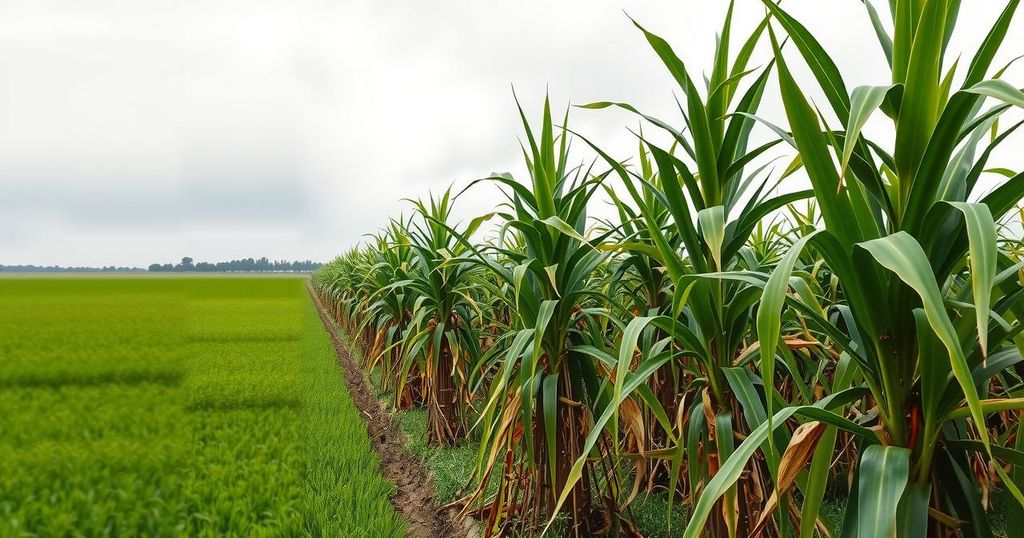Sugar Prices Decline Amid Brazilian Rain Forecasts and Production Adjustments

Sugar prices have declined due to rain forecasts in Brazil, alleviating dryness concerns and potentially boosting sugarcane yields. Reports indicate lowered global sugar production, with significant revisions from key producers, leading to a tighter market outlook. Meanwhile, increased outputs in Thailand and easing export restrictions in India could exert bearish pressures on prices.
Sugar prices have experienced a decline today, with May NY world sugar 11 (SBK25) decreasing by 0.18 cents (-0.94%), and May London ICE white sugar 5 (SWK25) dropping by 1.40 cents (-0.26%). The observed downturn follows forecasts for rain in Brazil, which are expected to alleviate dryness concerns and potentially enhance sugarcane yields.
Initially, sugar prices had increased this week, reaching a two-week high, due to reductions in global sugar production. Notably, Unica reported a decrease of 5.6% in cumulative 2024/25 Center-South sugar output through February, amounting to 39.822 million metric tons (MMT). Furthermore, the Indian Sugar and Bio-energy Manufactures Association revised its 2024/25 sugar production forecast to 26.4 MMT, down from 27.27 MMT, attributing this to lower cane yields.
The International Sugar Organization (ISO) updated its forecasts last Thursday, predicting a global sugar deficit of 4.88 MMT for 2024/25, a significant increase from November’s estimate of 2.51 MMT. Additionally, the ISO reduced its global sugar production forecast to 175.5 MMT, down from 179.1 MMT in November. Green Pool Commodity Specialists had previously suggested a shift to a surplus of 2.7 MMT in 2025/26, improving from a deficit of 3.7 MMT in 2024/25.
Last Thursday also witnessed sugar prices reaching seven-week lows amid signs of diminished demand. This was highlighted by significant deliveries of 1.7 MMT of raw sugar from sugar traders Wilmar International Ltd and Sucres et Denrees SA against the March NY futures contract that expired on February 28, often viewed as a bearish signal.
In further bearish developments, consultancy Datagro projected that Brazil’s Center-South sugar production for 2025/26 would increase to 42.4 MMT, representing a 6% year-on-year increase. Additional reports from Czarnikow anticipated Brazil’s sugar production for the same period to achieve record levels at 43.6 MMT due to the profitability of sugar over ethanol cultivation.
On January 20, India announced plans to permit its sugar mills to export 1 MMT of sugar this season, easing prior export restrictions aimed at maintaining domestic supply. The Indian Sugar Mills Association estimates a production decrease of 17.5% year-on-year for 2024/25, resulting in a five-year low of 26.4 MMT.
Thailand’s projected sugar output increase is also exerting downward pressure on prices. The Office of the Cane and Sugar Board has forecasted a production rise of 18% year-on-year for 2024/25, reaching 10.35 MMT, following a yield of 8.77 MMT for 2023/24. Thailand remains a significant player as the world’s third-largest sugar producer and second-largest exporter.
Drought conditions and excessive heat in Brazil last year led to crop damage in the key sugar-producing region of Sao Paulo, with an estimated loss of up to 5 MMT of sugarcane reported by Green Pool Commodity Specialists. Brazil’s Conab adjusted its 2024/25 sugar production estimate down to 44 MMT due to these adverse conditions.
In contrast, the USDA projected on November 21 that global sugar production for 2024/25 would increase by 1.5% year-on-year, reaching 186.619 MMT, whereas global human sugar consumption is expected to grow by 1.2% to a record 179.63 MMT. Additionally, the USDA projects a decline in global sugar ending stocks by 6.1% year-on-year to 45.427 MMT.
In conclusion, the fluctuations in sugar prices are prominently influenced by weather forecasts in Brazil, projections of global production, and supply-demand dynamics. Rain forecasts in Brazil could mitigate drought impacts, while revisions in production estimates across global markets indicate a tightening sugar market. As various nations adjust their output forecasts, the sector remains keenly observant of developments that could further impact pricing.
Original Source: www.tradingview.com








